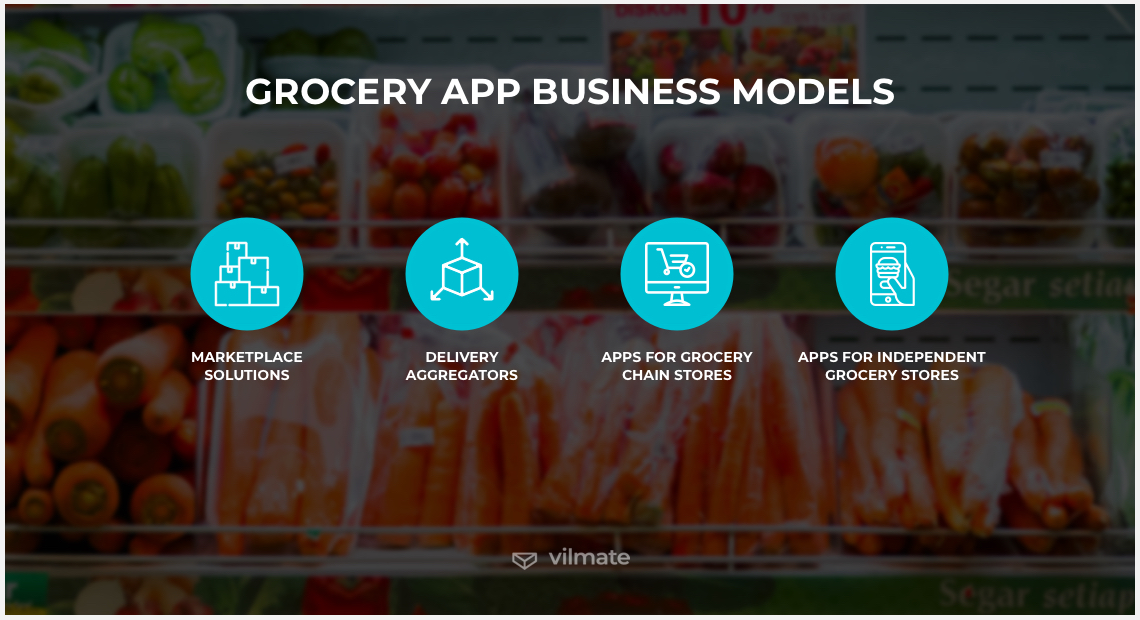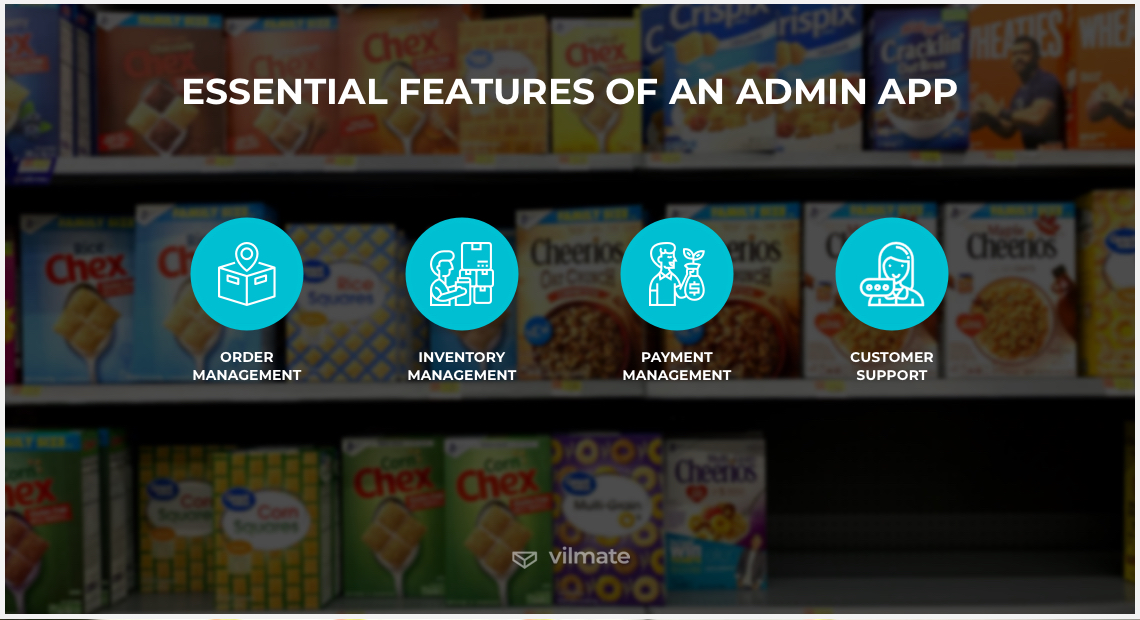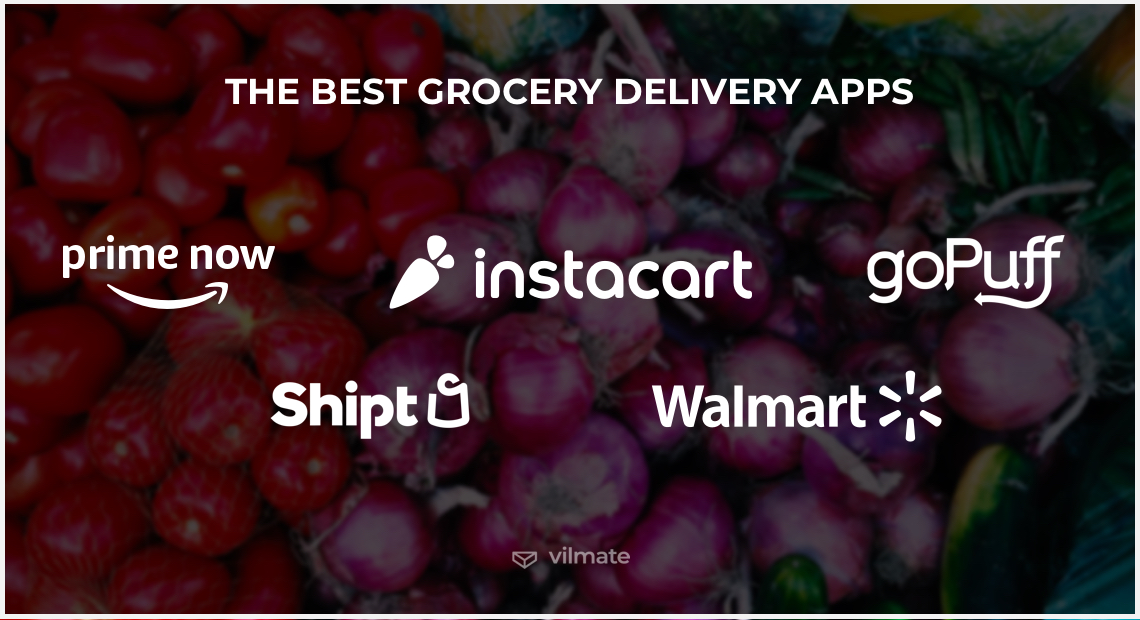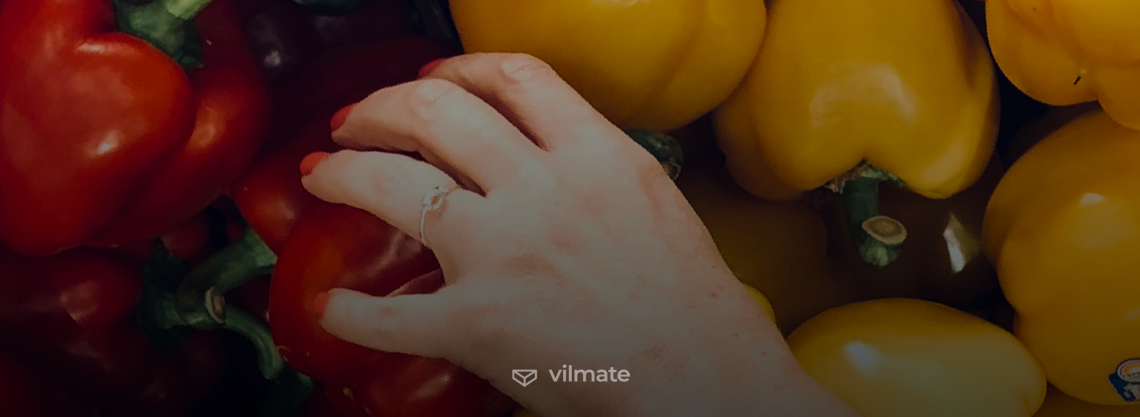Delivery applications are a trend that undoubtedly dominates the market in 2020. As the business landscape has changed due to the pandemic crisis, people have got to put more value on services that they can make use of without leaving their homes, not the least being grocery delivery. The virtues of online grocery shopping applications have already made them a lifeline for both stores and customers. Meanwhile, the growing competitiveness of the industry encourages businesses to deliver better services to consumers. Having the best-quality dairy, meat, produce, and many other delicacies brought to where you’ve requested – a gate, a door, curbside, etc. – is luxury that is becoming accessible to more and more of us.
Modern technologies can change the everyday lives of millions of people around the world for the better, and the popularity of grocery shopping applications proves this point. In this article, we are going to discover what benefits make us eager to take advantage of grocery delivery services, what online grocery business models exist nowadays, and how they work. We will also look into the must-have and killer features of grocery applications and illustrate this by considering several examples of successful grocery delivery businesses.
Why are grocery shopping applications becoming more popular?
Grocery shopping from home is becoming a commodity that many are happy to turn into part of their routine. According to Statista, South Korea leads the way with the staggering 20.3 percent of groceries bought online. In contrast, the UK, where 7.6 percent of groceries are ordered using a mobile app, is an absolute European leader of the online grocery sales market. It must be emphasized, however, that due to the coronavirus situation, the numbers have significantly increased. So, as the Guardian states, one in five British households bought groceries online in June 2020.
Of no less importance is the fact that, as statistics indicate, 72.9 percent of all retail e-commerce is expected to be developed from m-commerce in 2021, and it is calculated that 52% of the online population worldwide bought something online via mobile device in 2019.
Thus, looking at the big picture, this means that grocery shopping as one of the e-commerce markets and grocery shopping applications as a means to get goods delivered are to find their place in the sun and become a large share of the industry. These are the three big reasons for this to happier sooner rather than later:
1. They save time. Those who believe grocery shopping to be rather humdrum an occupation will be happy to let an application designed to address this very problem come and stay on their smartphones. These programs are true time savers! No more traffic jams on the way to the store, no more endless wandering along the aisles in search of one’s favorite pack of spaghetti or waiting in line waiting until others check out. Instead, you can order delivery from anywhere right to your doorstep.
2. They save money. Online grocery shopping applications can also help one economize. They can oftentimes provide you with a variety of deals and discounts and help you find coupons. When one goes directly to a grocery or convenience store, what they will find in stock or on sale there is a complete mystery until they are actually in the store. Using a grocery delivery application gives the privilege to choose the best-value deals available.
3. They eliminate impulsive buying. Of course, it is a bit easier to keep track of one’s expenses by coming up with a shopping list every time you need to go to the groceries, using a budgeting app, and simply following the general advice on how to not buy things impulsively. However, using a special app for ordering products, you will most probably have immediate access to online product reviews and, at the same time, won’t be able to touch, smell, or visually inspect the product that the marketing specialists have put lots of effort into. That may insure one from purchasing unnecessary things that just smell delicious, look attractive, or are pleasant to touch.
Grocery app business models
Grocery applications can vary. Although all of them have one common aim, which is to allow customers to order groceries and have them delivered in a timely manner, the business logic behind these solutions may be different. These are the most common grocery shopping app business models that one can easily come across:

Marketplace solutions. A marketplace platform is a popular form of e-commerce that is intended to connect sellers and buyers. In the case of grocery applications, a digital marketplace works as a place where customers can come, figuratively speaking, check the menu, and place an order. Then, a delivery driver takes this order and brings it to a customer. Grocery marketplaces have their own, usually comprehensive, menus that include a wide range of products and their own pool of delivery drivers.
Delivery aggregators. Applications developed under this business model offer a more seamless shopping experience to customers. With a grocery delivery aggregator like Instacart, they won’t have to choose which app to use. A delivery aggregator is a place to go to and shop for nearly anything. There, one normally finds a list of stores nearby and their menus. Then, customers are free to choose either a pick-up or delivery option. This business model is great for those businesses that want to serve as a third party for local grocery stores.
Apps for grocery chain stores. Big chain stores like Walmart, Kroger, or 7-Eleven often find themselves in a place where they do not want to become another store on the delivery aggregator’s list. So, this decision to design their own application becomes a turning point for the company. It gives them more control over the process flow and small details that matter even more when it comes to building a brand. Sometimes, it can also mean a broader selection of items and better quality of service, as the company is more likely to bring all of their assets and capabilities in one place.
Apps for independent grocery stores. A single grocery store can also sometimes show their willingness to obtain an online presence and develop a mobile grocery shopping app. Chances are there won’t be too many downloads, but the regular customers will definitely thank you for the gesture. When using such applications, customers should be able to get all the necessary up-to-date information to act on, including product availability and price, current discounts, or even add some nutritional facts.
Must-have features for a grocery shopping app
No doubt, if you want your brand to stand out from the crowd, then your online grocery app must have some unique features to offer to its users. But first, one has to ensure that all the essential functionalities are available and work as intended. So, let’s discuss in more detail what these features are for grocery shopping apps for customers, administrative personnel, and delivery drivers.
Powerful features of a customer app
A customer grocery shopping app must be the main focus of attention for the development team. This is going to be the app version downloadable from the app store, so it must be of the best quality possible. Apart from having smooth and modern-looking UI/UX, it must provide the following functionality:
User registration. When using an application for the first time, a customer should be prompted to sign up choosing the most convenient for them option (e.g., Gmail, Apple, Facebook, etc.) Also, remember not to ask for too much data while creating and configuring a user profile. So, first, request to provide only the information needed to place an order, process it, and deliver. Customers must always understand how relevant and necessary it is to ask for more.
Search. Advanced search, filters, categorization, and search suggestions will add to the favorability of user experience. All of this will help find exactly what is needed, filter out search results, and eventually save time. Quick and easy search is what makes grocery apps better than in-store experiences – searching for an item in a store naturally takes longer. However, if there are not many products to choose from in the first place or if the app returns irrelevant results or the availability of an item is displayed incorrectly, customers will find your application useless.
Shopping cart. Allow customers to add items to the cart, so that it would be easy to double-check what they are to buy. Also, they must be able to effortlessly save and return later to their cart-in-progress to place their order. Consider including a progress indicator for users to know where they are in the checkout process and a strong and clear call to action so they won’t feel confused. Make the workflow easy to follow and ensure that navigation between cart and store is uncomplicated.
Payment. Payment options in grocery shopping apps have to be secure and diverse. Providing multiple alternatives for payments means retaining more users. They have to be able to pay in cash, with a credit or debit card, using Apple Pay (and alike) or PayPal, etc. Give your users flexibility to pay the invoice generated after order placement and leave tips for delivery drivers in the most convenient way.
Users’ localization and address search. The location feature must enable an application to identify the user’s location. Integrating location features into grocery shopping apps is crucial for the customization and personalization of the user experience. Location-based content and notification are a must-have since delivery has to always be restricted to a certain radius. So, users will normally expect to see the locations that are within their reach.
Notifications. A push notification feature is essential for an online grocery shopping app as a way to inform users about order status updates, relevant deals and discounts, and more. Notifications can also remind customers to buy some products that the app has noticed them buying regularly, like milk, eggs, or butter. Just make sure all the notifications that a user receives are personalized and relevant to their goals while working with an application.
Order management. This includes real-time order tracking, order cancelation, and delivery scheduling. Give a customer a means for monitoring the order delivery process. It is also a good idea to let them get in touch with a delivery person inside an application and see the location of a delivery driver on the map. Also, users must have an option to cancel their order. This will give them the confidence that if their circumstances change, the app will be on their side. Finally, delivery scheduling is simply convenient as not many of us can afford to stay at home day at night waiting for their grocery to be delivered.
Feedback. Online grocery delivery apps are all about the quality of service. Reviews and other forms of feedback will help to raise this quality. It is good to know if there are any delivery drivers who do their job badly, (repeatedly fail to deliver in time, mix up orders, etc.) or if there are any problems with the product quality (which is the responsibility of the store).
Customer service helpdesk. Another form of quality assurance is customer service. If the issue must not only be considered but also addressed, customer service should offer their support to an unsatisfied user. The direct communication will help to resolve a problem in the most efficient manner, be it a request for a refund, missing items, mixed-up orders, disappointment with the service, or product quality.
The following are the features that would be a plus for a grocery app to have:
A wishlist. A possibility to create a list of products that a user would love to buy later is a nice thing to add to your grocery application. Thus, they will be able to find easily what they’ve been planning to buy for a special occasion or just to spoil themselves, no matter how much time has passed since they compiled that list.
Simplification of repeated orders. A list of favorite items simplifies navigation and makes it easier to check-out. It is a good idea to prompt a user to add a product that they have repeatedly purchased in the past so that they do not waste time on performing routine actions.
Essential nutrition information. This feature is a competitive advantage for a grocery app. In a separate section, you can provide comprehensive information about the item. For example, Cotsco has taken the advice too literally and added PDF files containing all the data on each product present in their online store, which is not a bad thing to do at all.
Price and product comparison. Only when shopping online, a customer can see such an effective comparison of similar products, define cost-effectiveness, and compare their quality factors. Alternatively, while in a store, it is not that easy to find out which product better matches customer’s needs and offers the best value-for-money.
Voice recognition. Artificial intelligence-powered features add to the product’s reputation nowadays. So, there is no harm in adding this feature to your application to please those who are used to talking to Alexa or Siri. No doubt it will be costly, that’s why we mention the feature in the list of extras, but if you have means for that, go ahead, and people will appreciate it.

Essential features of an admin app
The admin app or admin panel is the version of the application managed by the administrator of the main customer app. Admin Dashboard is critically important from the managerial point of view. It must be designed following the highest standards, as any failures occurring there will most probably affect the customer app. The must-have features to incorporate in an admin application include:
Order management - Who performs the administrative functions will depend on the app’s business model. So, one way or another, this person, the administrator, should have access to detailed information on each order placed. Then, according to product availability, the admin should accept or reject items on the list and suggest replacements if needed.
Inventory management - Using an in-built inventory management system, the administrator can help stores keep track of out-of-stocks and make sure that information about product availability is true. Real-time in-store inventory management must be reflected in the admin application.
Payment management - Orders must be paid on time, in full, and without overcharging. The job of the admin is to make sure it is really so, that stores and delivery people receive full payment once order delivery is successfully completed.
Customer support - The administrator should have access to customer reviews and ratings to act on them and ensure high service quality. An admin app must be a platform where an admin can communicate with clients and process returns and refunds.
Unique features of an app for delivery drivers
A mobile application for delivery drivers must be simple, so the very basic functionality will generally suffice. The app has to be able to do the following:
Register and sign in a delivery driver using a method of their choice.
Provide information about completed and ongoing deliveries in an organized manner.
Send notifications informing delivery drivers about new delivery requests.
Give drivers a means to accept or reject order deliveries.
Offer an in-built GPS navigation system capable of precisely directing drivers to the set destination.
Connect drivers with customers for driver-customer communication via a chat feature.
Transfer money upon the order completion, award bonuses, and offer details of the order transactions.
Examples of the best grocery delivery apps
When wondering how to build a grocery shopping app, many think about and go by an example of an application like Instacart. However, there are a number of other quite famous grocery delivery apps that have their advantages over Instacart and have something unique to offer to users. Let’s take a closer look at the top 5 examples of grocery delivery apps.

1. Instacart - It is a grocery aggregator that was founded in the US in 2012. Instacart store list is broad, so each customer will be able to find what they are looking for. So, if you want to know how to create an app like Instacart, the immediate answer is simple: do not complicate things. A primary input in the form of zip code – and a customer gets access to the menus of grocery stores nearby. Then, they can add products to a shopping cart, pick a delivery time, and wait for the order to be delivered right to their door. Upon delivery, an option to leave an online review unlocks. If anything has gone wrong, one can be sure they will be assisted in resolving the issue by the customer support specialist.
- Location: the USA and Canada.
- Fees: free delivery for Instacart Express members on orders over $35, standard delivery fee starting from $3.99 per Instacart delivery.
2. Shipt - Shipt application is another on-demand grocery delivery app that is now owned by Target. The app beta version was launched in the United States in 2014. It displayed quite a success and only kept multiplying it since then. Unlike Instacart, Shipt does not allow ordering to customers who have no membership. To examine the availability of Shipt’s partners, a customer has to enter their zip code. Shipt and Instacart may collaborate with different stores in different areas. So, although Instacart generally partners with a more significant number of stores, one always has to double-check their availability.
- Location: the US.
- Fees: free delivery for orders over $35 for, $7 for standard delivery. Shipt membership is a must - $99/yr or $14/mo.
3. Amazon Prime Now - When talking about the best grocery delivery apps, we cannot but mention Amazon Prime Now. It is a grocery delivery app that offers a variety of items from Amazon, Whole Foods, and a number of local stores like Bristol Farms or Gourmet Garage. A user traditionally has to enter their zip code to find out whether there is delivery available to their location. Otherwise, there is an option to pick up an order from a Whole Foods Market store. What makes Amazon Prime Now stand out is the quality of their customer service. A user can expect that they will always be on their side, and any issue will be immediately addressed.
- Location: the US.
- Fees: free delivery for orders over $35, $4.99 for orders under $35 for Prime members.
4. Walmart - Walmart’s pickup and delivery service is an excellent example of a supermarket delivery app. It is America’s one of the most famous chain stores that also has its own mobile delivery app, so we couldn’t help mentioning it in this list. The corporation currently has two separate products: Walmart Grocery – a typical app for grocery chain stores – and the main Walmart app. However, they have a plan to eliminate the grocery one and merge it with the main application. This is intended to prompt more users of the main application to buy groceries.
- Location: 1,600+ stores in the US.
- Fees: free pickup, the minimum purchase price is $30 for all orders to be free.
5. goPuff - goPuff is a Philadelphia-based grocery delivery service app founded in 2013 that is available for iOS and Android. Compared to other apps for grocery shopping, goPuff has a somewhat limited service coverage area, but it is actively seeking new ways for expansion. For instance, they recently took the initiative and started delivering groceries to doctors and nurses battling coronavirus. Yet, what they are most popular with is the availability of any drug store essentials and snack food. Who said it’s a bad thing?
- Location: 200+ facilities in 500 cities across the USA.
- Fees: $1.95 delivery fee flat or free delivery with the Fam membership of $5.95/mo.
Conclusion
The market for grocery shopping applications is mostly in its infancy. So, the question of how to create a grocery delivery app can still be a hot subject, especially in some countries and areas where competition is not too high, but the audience is ready for using the service. Importantly, during the coronavirus crisis and social distancing measures introduction, such applications are only becoming more popular, and some predict that this change will have long-lasting effects.
If you have an online grocery shopping app idea, let’s get in touch and see how we can partner up. Vilmate is open to discuss the best-fit technologies for developing features of your grocery delivery app. The time to try and make a difference is now!

© 2020, Vilmate LLC




